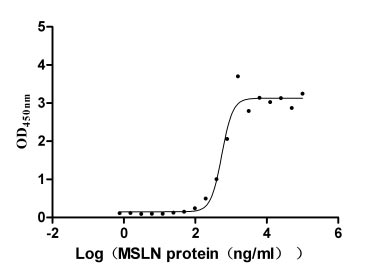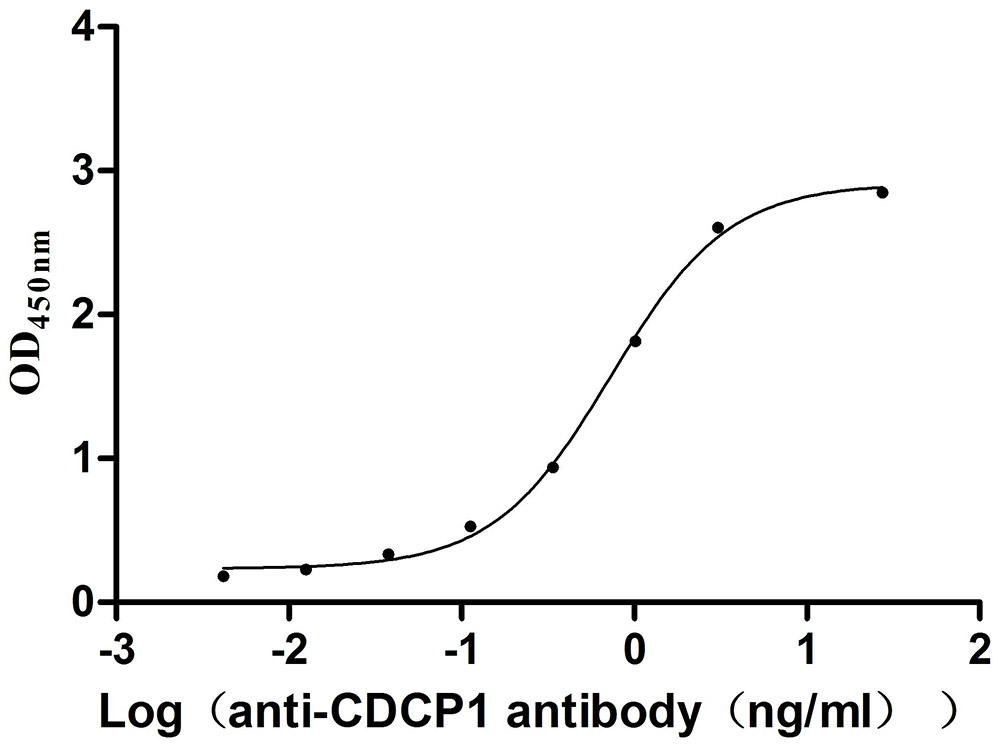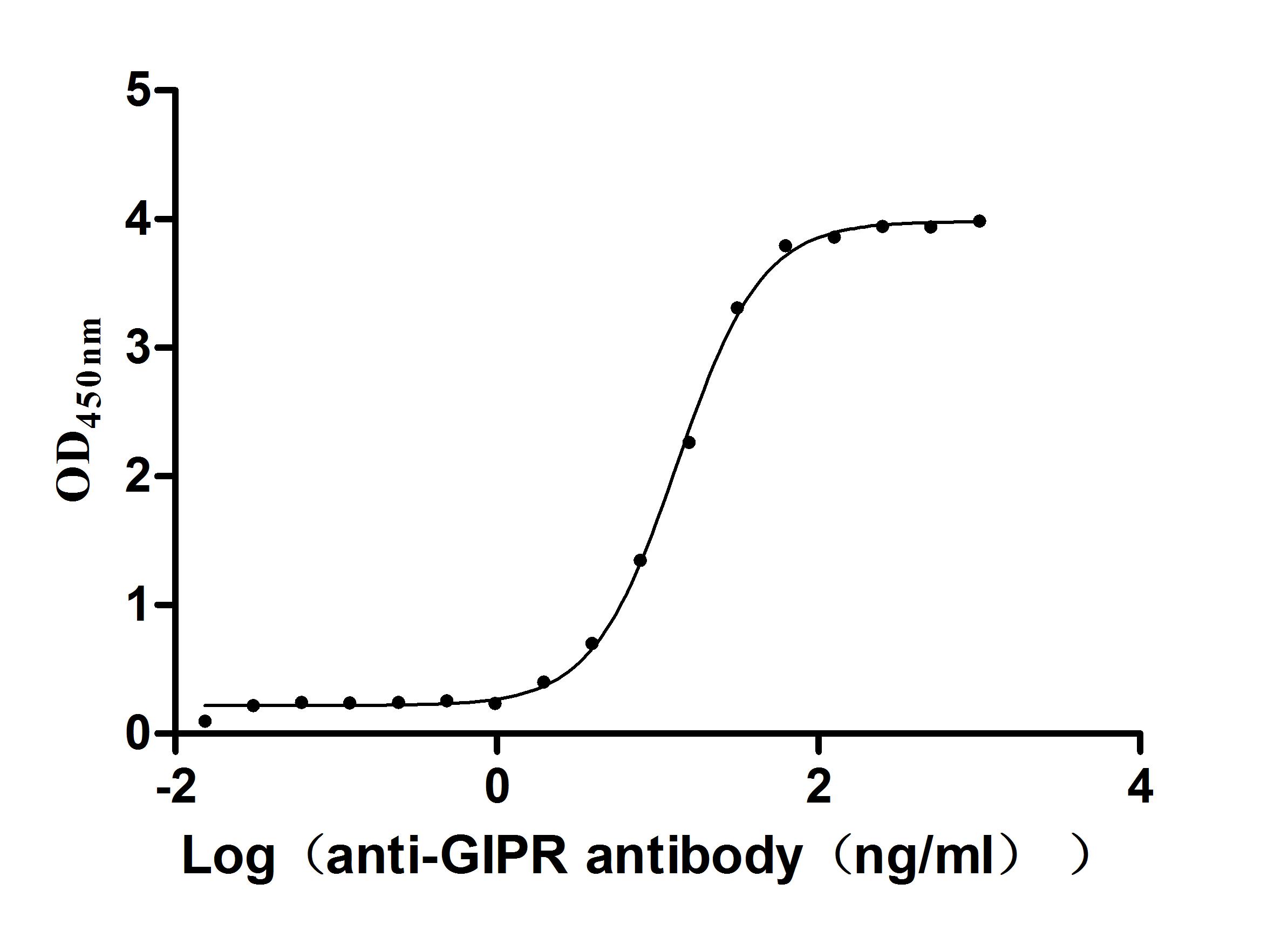Recombinant Mouse Osteocalcin (Bglap)
-
货号:CSB-YP002682MO
-
规格:
-
来源:Yeast
-
其他:
-
货号:CSB-EP002682MO-B
-
规格:
-
来源:E.coli
-
共轭:Avi-tag Biotinylated
E. coli biotin ligase (BirA) is highly specific in covalently attaching biotin to the 15 amino acid AviTag peptide. This recombinant protein was biotinylated in vivo by AviTag-BirA technology, which method is BriA catalyzes amide linkage between the biotin and the specific lysine of the AviTag.
-
其他:
-
货号:CSB-BP002682MO
-
规格:
-
来源:Baculovirus
-
其他:
-
货号:CSB-MP002682MO
-
规格:
-
来源:Mammalian cell
-
其他:
产品详情
-
纯度:>85% (SDS-PAGE)
-
基因名:Bglap
-
Uniprot No.:
-
别名:Bglap; Osteocalcin; Bone Gla protein; BGP; Gamma-carboxyglutamic acid-containing protein
-
种属:Mus musculus (Mouse)
-
蛋白长度:Full Length of Mature Protein
-
表达区域:50-95
-
氨基酸序列Y LGASVPSPDP LEPTREQCEL NPACDELSDQ YGLKTAYKRI YGITI
-
蛋白标签:Tag type will be determined during the manufacturing process.
The tag type will be determined during production process. If you have specified tag type, please tell us and we will develop the specified tag preferentially. -
产品提供形式:Lyophilized powder
Note: We will preferentially ship the format that we have in stock, however, if you have any special requirement for the format, please remark your requirement when placing the order, we will prepare according to your demand. -
复溶:We recommend that this vial be briefly centrifuged prior to opening to bring the contents to the bottom. Please reconstitute protein in deionized sterile water to a concentration of 0.1-1.0 mg/mL.We recommend to add 5-50% of glycerol (final concentration) and aliquot for long-term storage at -20℃/-80℃. Our default final concentration of glycerol is 50%. Customers could use it as reference.
-
储存条件:Store at -20°C/-80°C upon receipt, aliquoting is necessary for mutiple use. Avoid repeated freeze-thaw cycles.
-
保质期:The shelf life is related to many factors, storage state, buffer ingredients, storage temperature and the stability of the protein itself.
Generally, the shelf life of liquid form is 6 months at -20°C/-80°C. The shelf life of lyophilized form is 12 months at -20°C/-80°C. -
货期:Delivery time may differ from different purchasing way or location, please kindly consult your local distributors for specific delivery time.Note: All of our proteins are default shipped with normal blue ice packs, if you request to ship with dry ice, please communicate with us in advance and extra fees will be charged.
-
注意事项:Repeated freezing and thawing is not recommended. Store working aliquots at 4°C for up to one week.
-
Datasheet :Please contact us to get it.
相关产品
靶点详情
-
功能:Constitutes 1-2% of the total bone protein. It binds strongly to apatite and calcium.
-
基因功能参考文献:
- expression in offspring bone not changed by maternal high fat diet PMID: 25279792
- the uncarboxylated form of osteocalcin does not trigger Akt phosphorylation and glucose uptake by itself but promotes insulin-induced glucose uptake in myotubes, probably by up-regulating Akt signaling through ERK activation PMID: 25735975
- The Twist2-Cre, Osterix-Cre and osteocalcin-Cre lines to generate conditional beta1 integrin deletions, were used to investigate the role of beta1 integrins on skeletal phenotype. PMID: 25183373
- OCN is gamma-carboxylated by the gamma-carboxylase (GGCX) on three glutamic acid residues, a cellular process requiring reduction of vitamin K by a second enzyme, VKORC1. PMID: 25753038
- results showed an increase in the expression of Cbfa1 and OCN in fibroblasts and osteoblasts exposed to fluoride. PMID: 24680482
- Data indicate that Ca2+ binding triggered a similar conformational transition in both gamma-carboxyglutamic acid-containing protein osteocalcin (Gla-OCN) and Glu-OCN from a disordered structure to a more compact/stable form. PMID: 24896339
- In primary adipocytes, both carboxylated and uncarboxylated osteocalcin increased basal and insulin-stimulated glucose transport. PMID: 24554534
- Taken together, these findings demonstrate that SMILE negatively regulates osteocalcin via a direct interaction with RUNX2 PMID: 24389415
- Osteoblast-specific expression of Fra-2/AP-1 controls adiponectin and osteocalcin expression and affects metabolism. PMID: 24046454
- contribution of OC-OPN to fracture toughness is related to their presence at the extrafibrillar organic-mineral interfaces PMID: 24128197
- Insulin resistance in osteoblasts led to a decrease in circulating levels of the active form of osteocalcin, thereby decreasing insulin sensitivity in skeletal muscle. PMID: 24642469
- loss of osteocalcin/Gprc6a signaling has a profound effect on beta-cell mass accrual during late pancreas morphogenesis PMID: 24009262
- This study reveals that the skeleton via osteocalcin influences cognition and contributes to the maternal influence on fetal brain development. PMID: 24074871
- T3 stimulates the activation of Rho-kinase in osteoblasts, which functions as a negative regulator of T3-stimulated osteocalcin synthesis PMID: 23123502
- Uncarboxylated osteocalcin acts via Gprc6a to induce GLP-1 release from the gut; the stimulatory effect of uncarboxylated osteocalcin on insulin secretion is largely mediated by GLP-1. PMID: 23437377
- These results indicate that PP2A Calpha and its activity play a negative role in osteoblast differentiation and Osterix is a key factor responsible for regulating the expressions of Bsp and OCN during PP2A Calpha-mediated osteoblast differentiation. PMID: 23042641
- alphaNAC interacts with histone deacetylase corepressors to control Myogenin and Osteocalcin gene expression. PMID: 23092676
- Data from TR4 (steroid/thyroid hormone receptor 4) knockout mice suggest that TR4 binds to promoter region of osteocalcin gene and induces osteocalcin expression; this interaction maintains osteoblast activity during bone development/remodeling. PMID: 22676849
- Alterations of responses in knockout mice that suggest participation of osteocalcin in transmission of information about those sensory stimuli. PMID: 22350212
- BMP2 induces osteoblast differentiation through Runx2-dependent ATF6 expression, which directly regulates Oc transcription. PMID: 22102412
- Data show that Mkp1 KO mice displayed delayed differentiation and reduced expressions of osteocalcin (OCN) and Runx2 genes associated with osteoblast maturation and function. PMID: 21852324
- Both BGP overexpression and treatment with purified Bone Gla Protein (BGP) resulted in stabilization of hypoxia-inducible factor 1alpha (HIF-1alpha) in chondrocytes and vascular smooth muscle cells PMID: 21757657
- Foxo1 is a novel negative regulator of osteoblast-specific transcription factor Runx2 and modulates IGF1/insulin-dependent regulation of osteocalcin expression in osteoblasts. PMID: 21471200
- Data show that osteocalcin synthesis was significantly reduced in the stable HSP27-transfected MC3T3-E1 cells and normal human osteoblasts. PMID: 21427224
- Findings expand the biological importance of osteocalcin, begin to unravel its molecular mode of action, and provide the first evidence that the skeleton is an endocrine regulator of fertility. PMID: 21333348
- the activation of PPARgamma inhibits osteocalcin expression both by suppressing the expression of Runx2 and by interfering with the transactivation ability of Runx2 PMID: 12704187
- 1,25-(OH)(2)D(3)and T3 upregulated osteocalcin, depending on the stage of cell differentiation. PMID: 12798773
- osteocalcin fibroblast growth factor response element activation is enhanced by MINT, the Msx2 interacting nuclear matrix target PMID: 15131132
- Nell-1 reduced osterix-producing cells and increased bone sialoprotein, osteocalcin, and BMP-7 expression. PMID: 16936265
- Expression of the osteoblast-specific gene OC was examined in marrow stromal cell cultures at various time points. PMID: 17705049
- during osteoblast differentiation, early on, when Runx2 protein and DNA-binding are maximal, Runx2 is nearly absent from the OC promoter. Later, Runx2 is recruited to the OC promoter as Runx2 mRNA, protein, and in vitro DNA binding progressively decrease. PMID: 18821584
- Results show that induction of alkaline phosphatase, type I collagen, osteocalcin, CD44, CD47 and CD51 by mevinolin is responsible for the osteoblastic differentiation of D1 cells. PMID: 19162043
显示更多
收起更多
-
亚细胞定位:Secreted.
-
蛋白家族:Osteocalcin/matrix Gla protein family
-
组织特异性:Bone.
-
数据库链接:
KEGG: mmu:12096
STRING: 10090.ENSMUSP00000075425
UniGene: Mm.389459
Most popular with customers
-
Recombinant Human Tumor necrosis factor ligand superfamily member 18 (TNFSF18), partial (Active)
Express system: Mammalian cell
Species: Homo sapiens (Human)
-
Recombinant Human Mucin-16 (MUC16), partial (Active)
Express system: Mammalian cell
Species: Homo sapiens (Human)
-
Recombinant Human Tumor necrosis factor ligand superfamily member 8 (TNFSF8), partial (Active)
Express system: Mammalian cell
Species: Homo sapiens (Human)
-
Recombinant Human C-X-C chemokine receptor type 4 (CXCR4)-VLPs (Active)
Express system: Mammalian cell
Species: Homo sapiens (Human)
-
Recombinant Dog B-lymphocyte antigen CD20 (MS4A1)-VLPs (Active)
Express system: Mammalian cell
Species: Canis lupus familiaris (Dog) (Canis familiaris)
-
Recombinant Mouse CUB domain-containing protein 1 (Cdcp1), partial (Active)
Express system: Mammalian cell
Species: Mus musculus (Mouse)
-
Recombinant Human Serine/threonine-protein kinase receptor R3 (ACVRL1), partial (Active)
Express system: Baculovirus
Species: Homo sapiens (Human)
-
Recombinant Macaca Gastric inhibitory polypeptide receptor(GIPR), partial (Active)
Express system: yeast
Species: Macaca fascicularis (Crab-eating macaque) (Cynomolgus monkey)





-AC1.jpg)














